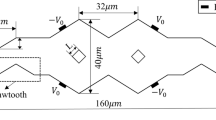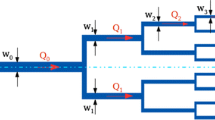Abstract
A bi-membrane structure is the main component of flow regulators for microfluidics with positive gain actuation. This microstructure is composed of two deformable circular membranes with different area tied by a rigid link that makes them move together. A comprehensive analysis of this microstructure is presented in this paper, which also provides an easy and practical design process in microsystems. The study is based on the microstructure behavior in typical microfluidic networks and is presented using dimensionless plots which have been obtained by numerical simulations based on finite element method performed by CoventorWare. The microstructure is defined using four dimensionless numbers for its seven dimensional parameters, and a dimensionless pressure. This fact represents the universal character of the design, dividing it into geometrical and material parts. The dimensionless pressure allows the use of any homogeneous and isotropic material in the design process of the devices. The values obtained from the plots are compared with simulation results using specific materials and dimensions and these comparisons present good agreement. Using the proposed analysis and design process, this sort of microstructures can be used by MEMS designers as standard components in microfluidic devices.














Similar content being viewed by others
References
Baek KH, Seo YT, Bang YS, Lee D, Kim JM, Kim YK (2011) Design, fabrication and characterization of piezoelectric micro-cantilever operated in liquid environment for ultrasound energy source applications. Microsyst Technol 17(8):1319–1327
Brazel CS, Peppas NA (1999) Dimensionless analysis of swelling of hydrophilic glassy polymers with subsequent drug release from relaxing structures. Biomaterials 20(8):721–732
del Campo A, Greiner C (2007) SU-8: a photoresist for high-aspect-ratio and 3D submicron lithography. J Micromech Microeng 17:R81–R95
CoventorInc (2010) CoventorWare—architect and analyzer: Users and Reference Guide
Decuzzi P, Srolovitz DJ (2004) Scaling laws for opening partially adhered contacts in MEMS. J Microelectromech Syst 13:377–385
Fan Z, Chen C, Hu W (2011) A numerical study on the large deformations of polymer foams with spherical pores. Adv Mater Res 295–297:1581–1585
Gosselin FP, de Langre E (2011) Drag reduction by reconfiguration of a poroelastic system. J Fluids Struct 27(7):1111–1123
Hoxhold B, Büttgenbach S (2010) Easily manageable, electrothermally actuated silicon micro gripper. Microsyst Technol 16(8–9):1609–1617
Ilis GG, Mobedi M, Ülkü S (2011) A dimensionless analysis of heat and mass transport in an adsorber with thin fins; uniform pressure approach. Int Commun Heat Mass Transfer 38(6):790–797
Jacob N, Yuen SCK, Nurick G, Bonorchis D, Desai S, Tait D (2004) Scaling aspects of quadrangular plates subjected to localised blast loads—experiments and predictions. Int J Impact Eng 30(8–9):1179–1208
Jr JJN, Gabriel KJ (2002) CMOS-MEMS membrane for audio-frequency acoustic actuation. Sens Actuators A Phys 95(2–3):175–182
Li QM, Jones N (2000) On dimensionless numbers for dynamic plastic response of structural members. Archive Appl Mech 70(4):245–254
Liu C (2007) Recent developments in polymer MEMS. Adv Mater 19(22):3783–3790
Lorenz H, Despont M, Fahrni N, LaBianca N, Renaud P, Vettiger P (1997) SU-8: a low-cost negative resist for MEMS. J Micromech Microeng 7(3):121–124
Matovic J, Jaksic Z (2009) A comparative analyze of fundamental noise in cantilever sensors based on lateral and longitudinal displacement: case of thermal infrared detectors. Microsyst Technol 16(5):755–763
Nurick G, Martin J (1989a) Deformation of thin plates subjected to impulsive loading—a review: Part i: theoretical considerations. Int J Impact Eng 8(2):159–170
Nurick G, Martin J (1989b) Deformation of thin plates subjected to impulsive loading—a review part II: experimental studies. Int J Impact Eng 8(2):171–186
Oh KW, Ahn CH (2006) A review of microvalves. J Micromech Microeng 16(22):R13–R39
Perdigones F, Luque A, Quero JM (2010) Novel structure for a pneumatically controlled flow regulator with positive gain. J Microelectromech Syst 19:1070–1078
Perdigones F, Luque A, Gañán-Calvo A, Quero JM (2011a) Highly integrable flow regulator with positive gain. J Microelectromech Syst 20:12–14
Perdigones F, Luque A, Quero JM (2011b) Pneumatically actuated positive gain microvalve with n-channel metal-oxide semiconductor-like behaviour. Micro Nano Lett 6:363–365
Shearwood C, Harradine M, Birch T, Stevens J (1996) Applications of polyimide membranes to mems technology. Microelectron Eng 30(1–4):547–550
Spratley J, Ward M, Hall P (2007) Bending characteristics of SU-8. Micro Nano Lett 2(2):20–23
Squires TM, Quake SR (2005) Microfluidics: Fluid physics at the nanoliter scale. Rev Mod Phys 77:977–1026
Teh WH, Liang CT, Graham M, Smith CG (2003) Cross-linked PMMA as a low-dimensional dielectric sacrificial layer. J Microelectromech Syst 12:641–648
Wouters K, Puers R (2009) Determining the Young’s modulus and creep effects in three different photo definable epoxies for MEMS applications. Sens Actuators A Phys 156(1):196–200
Yamamoto M, Takeuchi H, Aoki S (2000) Dimensional measurement of high aspect ratio micro structures with a resonating micro cantilever probe. Microsyst Technol 6(5):179–183
Yang X, Grosjean C, Tai YC (1999) Design, fabrication, and testing of micromachined silicone rubber membrane valves. J Microelectromech Syst 8:393–402
Yuedong Y, Jiali G (2011) Characteristics of non-Darcy flow in low-permeability reservoirs. Petroleum Sci 8(1):55–62
Zhao YP (1998) Suggestion of a new dimensionless number for dynamic plastic response of beams and plates. Archive Appl Mech 68(7–8):524–538
Author information
Authors and Affiliations
Corresponding author
Rights and permissions
About this article
Cite this article
Perdigones, F., Luque, A., Gañán-Calvo, A.M. et al. Analysis and design process of a bi-membrane structure for micro-flow regulators. Microsyst Technol 19, 227–236 (2013). https://doi.org/10.1007/s00542-012-1628-4
Received:
Accepted:
Published:
Issue Date:
DOI: https://doi.org/10.1007/s00542-012-1628-4




